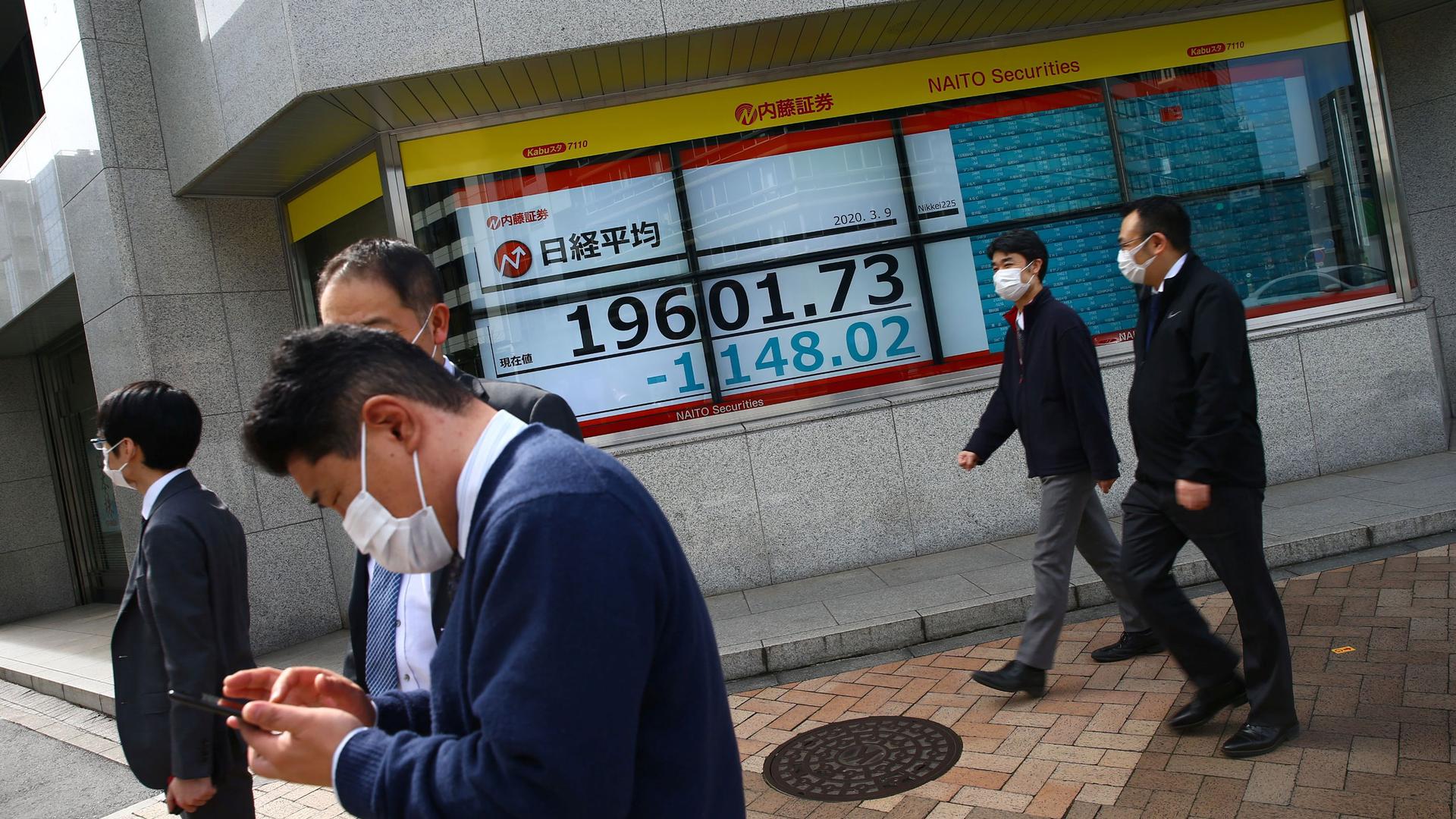People wearing protective face masks are seen near an electronic display showing the Nikkei index outside a brokerage in Tokyo, Japan, March 9, 2020.
Saudi Arabia has launched a price war with Russia worrying investors and sending global stocks plunging on Monday, as fears of the coronavirus outbreak continue to grow.
Saudi Arabia had stunned markets with plans to raise its production significantly after the collapse of OPEC’s supply cut agreement with Russia — a grab for market share reminiscent of a drive in 2014 that sent prices down by about two-thirds.
Brent crude and US crude futures slid as much as $14 to trade at $31.02 and $27.34 a barrel in chaotic trade before recovering some of their losses.
European equity markets suffered hefty losses with London, Frankfurt and Paris tumbling between 6-7%. Italy’s main index slumped 10% after the government ordered a lockdown of large parts of the north of the country, including the financial capital Milan.
The pan-regional STOXX 600 fell into bear market territory — a drop of more than 20% from its February peak. Oil stocks sank, with Premier Oil down 54% and energy giant BP trading nearly 20% lower.
Heavy selling was set to continue on Wall Street with US futures hitting their down limit.
“We are seeing this week, finally, a full-scale liquidation and signs of capitulation, full-scale panic — we see this in every asset,” said Paul O’Connor, head of multi-asset at Janus Henderson.
“The oil price plunge adds a huge disruptive dynamic to markets that are already very fragile – investors are looking for losers in this move.”
The losses in Europe followed sharp declines in Asia. MSCI’s broadest index of Asia-Pacific shares ex-Japan lost 4.4% in its worst day since August 2015 and Japan’s Nikkei dropped 5.1%. Australia’s commodity-heavy market closed down 7.3%, its biggest daily fall since the 2008 global financial crisis.
Investors piled into safe-haven bonds, driving the 30-year US bond yields beneath 1% on bets that the Federal Reserve will be forced to cut interest rates by at least 75 basis points at its March 18 meeting, after having already delivered an emergency easing last week.
The US 10-year Treasury yield fell to as low as 0.318% in its biggest daily fall since 2011 — during a sovereign debt crisis across the euro zone.
The number of people infected with the coronavirus rose above 110,000, and 3,800 have died from the virus.
There were mounting worries that US oil producers that had issued a lot of debt would be made uneconomic by the price drop.
The mood was also hit by North Korea firing three projectiles off its eastern coast.
Noting that many central banks had little scope to ease further, Martin Whetton, head of bond & rates strategy at CBA, said “let’s hope we start to see some more clarity on the reaction.”
Bond Bonanza
Markets fully priced in an easing of 75 basis points from the Fed on March 18, while a cut to near zero was now seen as likely by April.
The European Central Bank meets on Thursday and will be under intense pressure to act, but rates are already deeply negative.
“This week’s ECB meeting will be the first test case for ECB President Christine Lagarde,” ING’s eurozone chief economist Carsten Brzeski wrote in a note. “With hardly any ammunition left and confronted with an external shock which cannot be tamed by economic policies, the ECB will have to balance carefully between words and deeds.”
The 10-year Bund yield — the eurozone’s leading safe asset — fell to a new record low of -0.863% while inflation expectations for the eurozone sank below 1% for the first time.
Data suggested the global economy toppled into recession this quarter. Figures out from China over the weekend showed exports fell 17.2% in January-February from a year earlier.
The fall in US yields and Fed rate expectations pushed the dollar to its largest weekly loss in four years before it recovered some ground.
The dollar extended its slide to 101.58 yen, depths not seen since late 2016. It was last down nearly 3% at 102.42.
The euro shot to the highest in over 13 months at $1.1492, to be last at $1.1410.
Gold initially cleared $1,700 per ounce to a fresh seven-year peak, only to fall back to $1,677.4 amid talk some investors were having to sell to raise cash to cover margin calls in stocks.
By Karin Strohecker/Reuters
Our coverage reaches millions each week, but only a small fraction of listeners contribute to sustain our program. We still need 224 more people to donate $100 or $10/monthly to unlock our $67,000 match. Will you help us get there today?
